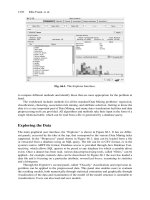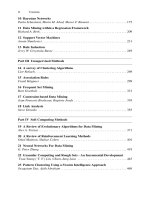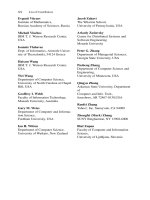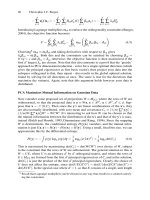Data Mining and Knowledge Discovery Handbook, 2 Edition part 27 docx
Bạn đang xem bản rút gọn của tài liệu. Xem và tải ngay bản đầy đủ của tài liệu tại đây (387.16 KB, 10 trang )
240 Armin Shmilovici
A tube with radius
ε
is fitted to the data, and a regression function that generalizes
well is then found by controlling both the regression capacity (via
w
) and the loss
function. One possible realization, called C-SVR, of a is minimizing the following
objective function
min
w,b,
ξ
1
2
w
2
+C
n
∑
i=1
|
y
i
− f (x)
|
ε
(12.24)
The regularization constant C > 0 determines the trade-off between the empirical
error and the complexity term.
Fig. 12.4. In SV regression, a tube with radius
ε
is fitted to the data. The optimization deter-
mines a trade-off between model complexity and points lying outside of the tube. Figure taken
from Smola and Scholkopf (2004).
Generalization to kernel-based regression estimation is carried out in complete
analogy with the classification problem. Introducing Lagrange multipliers and choos-
ing a-priory the regularization constants C,
ε
one arrives at a dual quadratic optimiza-
tion problem. The support vectors and the support values of the solution define the
following regression function
f (x)=
n
∑
i=1
α
i
K(x,x
i
)+b (12.25)
There are degrees of freedom for constructing SVR, such as how to penalize or
regularize different parts of the vector, how to use the kernel trick, and the loss func-
tion to use. For example, in the
ν
-SVR algorithm implemented in LIBSVM (Chang
and Lin 2001) one specifies an upper bound 0 ≤
ν
≤ 1 on the fraction of points al-
lowed to be outside the tube (asymptotically, the number of Support Vectors). For
a-priory chosen constants C,
ν
the dual quadratic optimization problem is as follows
max
α
,
α
∗
n
∑
i=1
(
α
∗
i
−
α
i
)y
i
−
1
2
n
∑
i, j=1
(
α
∗
i
−
α
i
)(
α
∗
j
−
α
j
)K(x
i
,x
j
) (12.26)
12 Support Vector Machines 241
Subject to 0 ≤
α
i
,
α
∗
i
≤
C
n
,
n
∑
i=1
(
α
∗
i
+
α
i
)
≤ C
ν
n
∑
i=1
(
α
∗
i
−
α
i
)
≤ C
ν
i = 1, ,n (12.27)
and the regression solution is expressed as
f (x)=
n
∑
i=1
(
α
∗
i
−
α
i
)K(x,x
i
)+b (12.28)
12.3.3 SVM-like Models
The power of SVM comes from the kernel representation that allows a non-linear
mapping of input space to a higher dimensional feature space. However, the resulting
quadratic programming equations may be computationally expensive for large prob-
lems. Smola et al. (1999) suggested an SVR like linear programming formulation
that retains the form of the solution (Equation 12.25) while replacing the quadratic
function in Equation 12.26 with a linear function subject to constraints on the error
of kernel expansion (Equation 12.25).
Suykens et al. (2002) introduced the least squares SVM (LS-SVM) in which they
modify the classifier of Equations 12.17-12.18 with the following equations:
min
w,b,e
1
2
w
2
+
γ
1
2
n
∑
i=1
e
2
i
(12.29)
Subject to
y
i
·((w ·
Φ
(x
i
)) + b)=1 −e
i
,
i = 1, ,n
(12.30)
Important differences with standard SVM are the equality constraint (see Equa-
tion 12.30) and the sum squared error terms, which greatly simplify the problem.
Incorporating Lagrange multipliers and solving leads to the following dual linear
problem:
0Y
T
Y +
γ
−1
I
·
b
α
=
0
I
(12.31)
where the primal variables
{
w,b
}
define as before a decision surface like Equation
12.14, Y =(y
1
, ,y
n
), (
Ω
)
i, j
= y
i
y
j
K (x
i
,x
j
), I,0 are appropriate size all ones (all
zeros) matrices, and
γ
is a tuning parameter to be optimized. Equivalently, modifying
the regression problem presented in Equations 12.26-12.27 also results in a linear
system like (Equation 12.31) with an additional tuning parameter.
The LS-SVM can realize strongly nonlinear decision boundaries, and efficient
matrix inversion methods can handle very large datasets. However,
α
is not sparse
anymore (Suykens et al. 2002).
12.4 Implementation Issues with SVM
The purpose of this section is to overview some problems that face the application of
SVM in machine learning.
242 Armin Shmilovici
12.4.1 Optimization Techniques
The solution of the SVM problem, is the solution of a constraint (convex) quadratic
programming (QP) problem such as Equations 12.15-12.16. Equation 12.15 can be
rewritten as maximizing −
1
2
α
T
ˆ
K
α
+ 1
T
α
, where 1 is a vector of all ones and
ˆ
K
i, j
=
y
i
y
j
k (x
i
,x
j
). When the Hessian matrix
ˆ
K is positive definite, the objective function
is convex and there is a unique global solution. If matrix
ˆ
K is positive semi-definite,
every maximum is also a global maximum, however, there can be several optimal
solutions (different in their
α
) which might lead to different performance on the
testing dataset.
In general, the support vector optimization can be solved analytically only when
the number of training data is very small. The worst case computational complexity
for the general analytic case results from the inversion of the Hessian matrix, thus is
of order N
3
S
, where N
S
is the number of support vectors. There exists a vast literature
on solving quadratic programs (Bertsekas 1995, Bazaraa et al. 1993) and several
software packages are available. However, most quadratic programming algorithms
are either only suitable for small problems or assume that the Hessian matrix
ˆ
K
is sparse, i.e., most elements of this matrix are zero. Unfortunately, this is not true
for the SVM problem. Thus, using standard quadratic programming codes with more
than a few hundred variables results in enormous training times and more demanding
memory needs. Nevertheless, the structure of the SVM optimization problem allows
the derivation of specially tailored algorithms, which allow for fast convergence with
small memory requirements, even on large problems.
A key observation in solving large-scale SVM problems is the sparsity of the
solution (Steinwart, 2004). Depending on the problem, many of the optimal
α
i
will
either be zero or on the upper bound. If one could know beforehand which
α
i
were
zero, the corresponding rows and columns could be removed from the matrix
ˆ
K
without changing the value of the quadratic form. Furthermore, a point can only be
optimal if it fulfills the KKT conditions (such as Equation 12.5). SVM solvers de-
compose the quadratic optimization problem into a sequence of smaller quadratic op-
timization problems that are solved in sequence. Decomposition methods are based
on the observations of Osuna et al. (1997) that each QP in a sequence of QPs always
contains at least one sample violating the KKT conditions. The classifier built from
solving the QP for part of the training data is used to test the rest of the training
data. The next partial training set is generated from combining the support vectors
already found (the ”working set”) with the points that most violate the KKT condi-
tions, such that the partial Hessian matrix will fit the memory. The algorithm will
eventually converge to the optimal solution. Decomposition methods differ in the
strategies for generating the smaller problems and use sophisticated heuristics to se-
lect several patterns to add and remove from the sub-problem plus efficient caching
methods. They usually achieve fast convergence even on large data sets with up to
several thousands of support vectors. A quadratic optimizer is still required as part
of the solver. Elements of the SVM solver can take advantage of parallel process-
ing: such as simultaneous computing of the Hessian matrix, dot products, and the
objective function. More details and tricks can be found in the literature (Platt, 1998,
12 Support Vector Machines 243
Joachims 1999, Smola et al. 2000, Lin 2001, Chang and Lin 2001, Chew et al. 2003,
Chung et al. 2004).
A fairly large selection of optimization codes for SVM classification and regres-
sion may be found on the Web (Kernel 2004), together with the appropriate refer-
ences. They range from simple MATLAB implementation to sophisticated C, C++,
or FORTRAN programs (e.g., LIBSVM: Chang and Lin 2001, SVMlight: Joachim
2004). Some solvers include integrated model selection and data rescaling proce-
dures for improved speed and numerical stability. Hsu et al. (2003) advises about
working with a SVM software on practical problems.
12.4.2 Model Selection
To obtain a high level of performance, some parameters of the SVM algorithm have
to be tuned. These include 1) the selection of the kernel function; 2) the kernel param-
eter(s); 3) the regularization parameters (C,
ν
,
ε
) for the tradeoff between the model
complexity and the model accuracy. Model selection techniques provide principled
ways to select a proper kernel. Usually, a sequence of models is solved, and using
some heuristic rules, next set of parameters is tested. The process is continued until a
given criterion is obtained (e.g., 99% correct classification). For example, if we con-
sider 3 alternative (single parameter) kernels, 5 partitions of the kernel parameters,
and one regularization parameters with 5 partitions each, then we need to consider a
total of 3x5x5=125 SVM evaluations.
The cross validation technique is widely used for a prediction of the generaliza-
tion error, and is included in some SVM packages (such as LIBSVM: Chang and Lin
2001). Here, the training samples are divided into k subsets of equal size. Then, the
classifier is trained k times: in the i-th iteration (i = 1, ,k), the classifier is trained
on all subsets except the i-th one. Then, the classification error is computed for the
i-th subset. It is known that the average of these k errors is a rather good estimate
of the generalization error. k is typically 5 or 10. Thus, for the example above we
need to consider at least 625 SVM evaluations to identify the model of the best SVM
classifier.
In the Bayesian evidence framework the training of an SVM is interpreted as
Bayesian inference, and the model selection is accomplished by maximizing the
marginal likelihood (i.e., evidence). Law and Kwok (2000) and Chu (2003) provide
iterative parameter updating formulas, and report a significantly smaller number of
SVM evaluations.
12.4.3 Multi-Class SVM
Though SVM was originally designed for two-class problems, several approaches
have been developed to extend SVM for multi-class data sets.
One approach to k-class pattern recognition is to consider the problem as a col-
lection of binary classification problems. The technique of one-against-the-rest re-
quires k binary classifiers to be constructed (when the label +1 is assigned to each
244 Armin Shmilovici
class in its turn and the label -1 is assigned to the other k −1 classes). In the predic-
tion stage, a voting scheme is applied to classify a new point. In the winner-takes-all
voting scheme, one assigns the class with the largest real value. The one-against-one
approach trains a binary SVM for any two classes of data and obtains a decision
function. Thus, for a k-class problem, there are k(k −1)/2 decision functions where
the voting scheme is designated to choose the class with the maximum number of
votes. More elaborate voting schemes, such as error-correcting-codes consider the
combined outputs from the n-parallel classifiers as a binary n-bit code word and se-
lects the class with the closest (e.g. Hamming distance) code.
In Hsu and Lin (2002), it was experimentally shown that for general problems,
using the C-SVM classifier, various multi-class approaches give similar accuracy.
Rifkin and Klautau (2004) have similar observation, however, this may not always be
the case. Multi-class methods must be considered together with parameter-selection
strategies. That is, we search for appropriate regularization parameters and kernel
parameters for constructing a better model. Chen, Lin and Scholkopf (2003) experi-
mentally demonstrate inconsistent and marginal improvement in the accuracy when
the parameters are trained differently for each classifier inside a multi-class C-SVM
and
ν
-SVM classifiers.
12.5 Extensions and Application
Kernel algorithms have solid foundations in statistical learning theory and functional
analysis, thus, kernel methods combine statistics and geometry. Kernels provide an
elegant framework for studying fundamental issues of machine learning, such as
similarity measures that can incorporate prior knowledge about the problem, and
data representations. SVM have been one of the major kernel methods for supervised
learning. It is not surprising that recent methods integrate SVM with kernel methods
(Scholkopf et al. 1999, Scholkopf and Smola, 2002, Shawe-Taylor and Cristianini
2004) for unsupervised learning problems such as density estimation (Weston and
Herbrich, 2000).
SVM has a strong analogy in regularization theory (Williamson et al., 2001).
Regularization is a method of solving problems by making some a-priori assump-
tions about the desired function. A penalty term that discourages over-fitting is added
to the error function. A common choice of regularizer is given by the sum of the
squares of the weight parameters and results in a functional similar to Equation 12.6.
Like SVM, optimizing a functional of the learning function, such as its smoothness,
leads to sparse solutions.
Boosting is a machine learning technique that attempts to improve a ”weak”
learning algorithm, by a convex combination of the original ”weak” learning func-
tion, each one trained with a different distribution of the data in the training set.
SVM can be translated to a corresponding boosting algorithm using the appropriate
regularization norm (Ratsch et al., 2001).
Successful applications of SVM algorithms have been reported for various fields,
such as pattern recognition (Martin et al. 2002), text categorization (Dumais 1998,
12 Support Vector Machines 245
Joachims 2002), time series prediction (Mukherjee, 1997), and bio-informatics (Zien
et al. 2000). Historically, classification experiments with the U.S. Postal Service
benchmark problem - the first real-world experiment of SVM (Cortes and Vapnik
1995, Scholkopf 1995) - demonstrated that plain SVMs give a performance very
similar to other state-of-the-art methods. SVM has been achieving excellent results
also on the Reuters-22173 text classification benchmark problem (Dumais, 1998).
SVMs have been strongly improved by using prior knowledge about the problem to
engineer the kernels and the support vectors with techniques such as virtual support
vectors (Scholkopf 1997, Scholkopf et al. 1998). Isabelle (2004) and Kernel (2004)
present many more applications.
12.6 Conclusion
Since the introduction of the SVM classifier a decade ago, SVM gained popular-
ity due to its solid theoretical foundation in statistical learning theory. They differ
radically from comparable approaches such as neural networks: they have a sim-
ple geometrical interpretation and SVM training always finds a global minimum.
The development of efficient implementations led to numerous applications. Selected
real-world applications served to exemplify that SVM learning algorithms are indeed
highly competitive on a variety of problems.
SVM are a set of related methods for supervised learning, applicable to both clas-
sification and regression problems. This chapter provides an overview of the main
SVM methods for the separable and non-separable case and for classification and
regression problems. However, SVM methods are being extended to unsupervised
learning problems.
A SVM is largely characterized by the choice of its kernel. The kernel can be
viewed as a nonlinear similarity measure, and should ideally incorporate prior knowl-
edge about the problem at hand. The best choice of kernel for a given problem is still
an open research issue. A second limitation is the speed of training. Training for very
large datasets (millions of support vectors) is still an unsolved problem.
References
Bazaraa M. S., Sherali H. D., and Shetty C. M. Nonlinear programming: theory and algo-
rithms. Wiley, second edition, 1993.
Bertsekas D.P. Nonlinear Programming. Athena Scientific, MA, 1995.
Chang C C. and Lin C J. Training support vector classifiers: Theory and algorithms. Neural
Computation 2001; 13(9):2119–2147.
Chang C C. and Lin C J. (2001). LIBSVM: a library for support vector machines. Software
available at />Chen P H., Lin C. -J., and Scholkopf B. A tutorial on nu-support vector machines. 2003.
Chew H. G., Lim C. C., and Bogner R. E. An implementation of training dual-nu support
vector machines. In Qi, Teo, and Yang, editors, Optimization and Control with Applica-
tions. Kluwer, 2003.
246 Armin Shmilovici
Chu W. Bayesian approach to support vector machines. PhD thesis, National
University of Singapore , 2003; Available online />chu03bayesian.html
Chung K M., Kao W C., Sun C L., and Lin C J. Decomposition methods for linear support
vector machines. Neural Computation 2004; 16(8):1689-1704).
Cortes C. and Vapnik V. Support vector networks. Machine Learning 1995; 20:273–297.
Cristianini N. and Shawe-Taylor J. An Introduction to Support Vector Machines and other
kernel-based learning methods. Cambridge Univ. Press, 2000.
Dumais S. Using SVMs for text categorization. IEEE Intelligent Systems 1998; 13(4).
Hsu C W. and Lin C J. A comparison of methods for multi-class support vector machines
IEEE Transactions on Neural Networks 2002; 13(2); 415–425.
Hsu C W. Chang C C and Lin C J. A practical guide to support vector clas-
sification. 2003. Available Online: www.csie.ntu.edu.tw/∼cjlin/papers/guide
/guide.pdf
Isabelle 2004, (a collection of SVM applications) Available Online: http://
www.clopinet.com/isabelle/Projects/SVWM/applist.html
Joachims T. Making large–scale SVM learning practical. In Scholkopf B., Burges C. J. C.,
and Smola A. J., editors, Advances in Kernel Methods — Support Vector Learning,
pages 169–184, Cambridge, MA, MIT Press, 1999.
Joachims T. Learning to Classify Text using Support Vector Machines Methods, Theory, and
Algorithms. Kluwer Academic Publishers, 2002.
Joachims T. 2004, SVMlight, available online
/People/tj/svm
light/
Kernel 2004, (a collection of literature, software and Web pointers dealing with SVM and
Gaussian processes) Available Online .
Law M. H. and Kwok J. T. Bayesian support vector regression. Proceedings of the 8th Inter-
national Workshop on Artificial Intelligence and Statistics (AISTATS) pages 239-244,
Key-West, Florida, USA, January 2000.
Lin C J. Formulations of support vector machines: a note from an optimization point of
view. Neural Computation 2001; 13(2):307–317.
Lin C J. On the convergence of the decomposition method for support vector machines.
IEEE Transactions on Neural Networks 2001; 12(6):1288–1298.
Martin D. R., Fowlkes C. C., and Malik J. Learning to detect natural image boundaries using
brightness and texture. In Advances in Neural Information Processing Systems, volume
14, 2002.
Mukherjee S., Osuna E., and Girosi F. Nonlinear prediction of chaotic time series using a
support vector machine. In Principe J., Gile L., Morgan N. and Wilson E. editors, Neural
Networks for Signal Processing VII - proceedings of the 1997 IEEE Workshop, pages
511–520, New-York, IEEE Press, 1997.
Muller K R., Mika S., Ratsch G., Tsuda K., and Scholkopf B., An introduction to kernel-
based learning algorithms. IEEE Neural Networks 2001; 12(2):181-201.
Osuna E., Freund R., and Girosi F. An improved training algorithm for support vector ma-
chines. In Principe J., Gile L., Morgan N. and Wilson E. editors, Neural Networks for
Signal Processing VII - proceedings of the 1997 IEEE Workshop, pages 276-285, New-
York, IEEE Press, 1997.
Platt J. C. Fast training of support vector machines using sequential minimal optimization.
In Scholkopf B., Burges C. J. C., and Smola A. J., editors, Advances in Kernel Methods
- Support Vector Learning, Cambridge, MA, MIT Press, 1998.
12 Support Vector Machines 247
Ratsch G., Onoda T., and Muller K.R. Soft margins for AdaBoost. Machine Learning 2001;
42(3):287–320.
Rifkin R. and Klautau A In Defense of One-vs-All Classification, Journal of Machine
Learning Research 2004; 5:101-141.
Scholkopf B., Support Vector Learning. Oldenbourg Verlag, Munich, 1997.
Scholkopf B., Statistical learning and kernel methods, Technical Report MSR-
TR-2000-23, Available Online />/view.aspx?msr
tr id= MSR-TR-2000-23
Scholkopf B., Burges C.J.C., and Vapnik V.N. Extracting support data for a given task. In
Fayyad U.M. and Uthurusamy R., Editors, Proceedings, First International Conference
on Knowledge Discovery and Data Mining. AAAI Press, Menlo Park, CA, 1995.
Scholkopf B., Simard P.Y., Smola A.J., and Vapnik V.N Prior knowledge in support vector
kernels. In Jordan M., Kearns M., and Solla S., Editors, Advances in Neural Information
Processing Systems 10, pages 640–646. MIT Press, Cambridge, MA, 1998.
Scholkopf B., Burges C. J. C., and Smola A. J., editors, Advances in Kernel Methods -
Support Vector Learning, Cambridge, MA, MIT Press, 1999.
Scholkopf B. and Smola A. J. Learning with Kernels. MIT Press, Cambridge, MA, 2002.
Scholkopf B., Smola A. J., Williamson R. C., and Bartlett P. L. New support vector algo-
rithms. Neural Computation 2000; 12:1207–1245.
Shawe-Taylor J. and Cristianini N. Kernel Methods for Pattern Analysis. Cambridge Univer-
sity Press, 2004.
Smola A. J., Bartlett P. L., Scholkopf B. and Schuurmans D. Advances in Large Margin
Classifiers. MIT Press, Cambridge, MA, 2000.
Smola A.J. and Scholkopf B A tutorial on support vector regression. Statistics and Com-
puting 2004; 14(13):199-222.
Smola A.J., Scholkopf B. and Ratsch G. Linear programs for automatic accuracy control
in regression. Proceedings of International Conference on Artificial Neural Networks
ICANN’99, Berlin, Springer 1999.
Steinwart I. On the optimal parameter choice for nu-support vector machines.
IEEE Transactions on Pattern Analysis and Machine Intelligence 2003; 25:
1274-1284.
Steinwart I. Sparseness of support vector machines. Journal of Machine Learning Research
2004; 4(6):1071-1105.
Suykens J.A.K., Van Gestel T., De Brabanter J., De Moor B., and Vandewalle J. Least
Squares Support Vector Machines. World Scientific Publishing, Singapore, 2002.
Vapnik V. The Nature of Statistical Learning Theory . Springer Verlag, New York, 1995.
Vapnik V. Statistical Learning Theory. Wiley, NY, 1998.
Vapnik V. and Chapelle O. Bounds on error expectation for support vector machines. Neural
Computation 2000; 12(9):2013–2036.
Weston J. and Herbrich R., Adaptive margin support vector machines. In Smola A.J., Bartlett
P.L., Scholkopf B., and Schuurmans D., Editors, Advances in Large Margin Classifiers,
pages 281–296, MIT Press, Cambridge, MA, 2000,.
Williamson R. C., Smola A. J., and Scholkopf B., Generalization performance of regulariza-
tion networks and support vector machines via entropy numbers of compact operators.
IEEE Transactions on Information Theory 2001; 47(6):2516–2532.
Wolfe P. A duality theorem for non-linear programming. Quartely of Applied Mathematics
1961; 19:239–244.
Zien A., Ratsch G., Mika S., Scholkopf B., Lengauer T. and Muller K.R. Engineering sup-
port vector machine kernels that recognize translation initiation sites. Bio-Informatics
16(9):799–807.
13
Rule Induction
Jerzy W. Grzymala-Busse
University of Kansas
Summary. This chapter begins with a brief discussion of some problems associated with
input data. Then different rule types are defined. Three representative rule induction methods:
LEM1, LEM2, and AQ are presented. An idea of a classification system, where rule sets are
utilized to classify new cases, is introduced. Methods to evaluate an error rate associated with
classification of unseen cases using the rule set are described. Finally, some more advanced
methods are listed.
Key words: Rule induction algorithms LEM1, LEM2, and AQ; LERS Data Mining
system, LERS classification system, rule set types, discriminant rule sets, validation.
13.1 Introduction
Rule induction is one of the most important techniques of machine learning. Since
regularities hidden in data are frequently expressed in terms of rules, rule induction
is one of the fundamental tools of Data Mining at the same time. Usually rules are
expressions of the form
if (attribute −1, value −1) and (attribute −2,value −2) and ···
and (attribute−n, value −n) then (decision, value).
Some rule induction systems induce more complex rules, in which values of
attributes may be expressed by negation of some values or by a value subset of the
attribute domain.
Data from which rules are induced are usually presented in a form similar to a
table in which cases (or examples) are labels (or names) for rows and variables are
labeled as attributes and a decision. We will restrict our attention to rule induction
which belongs to supervised learning: all cases are preclassified by an expert. In dif-
ferent words, the decision value is assigned by an expert to each case. Attributes are
O. Maimon, L. Rokach (eds.), Data Mining and Knowledge Discovery Handbook, 2nd ed.,
DOI 10.1007/978-0-387-09823-4_13, © Springer Science+Business Media, LLC 2010









